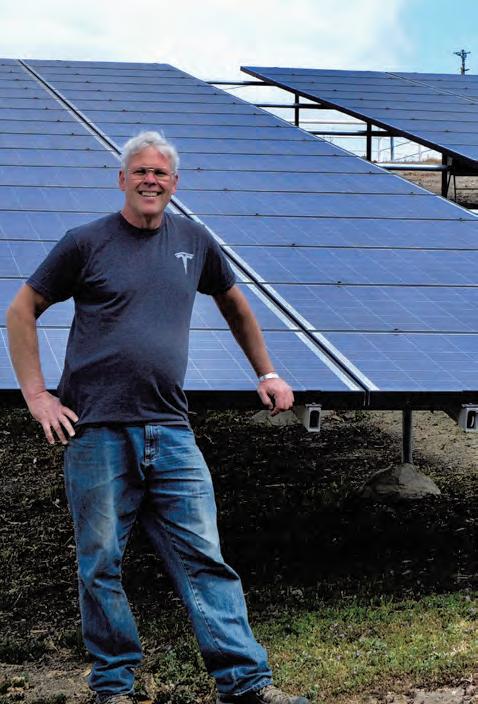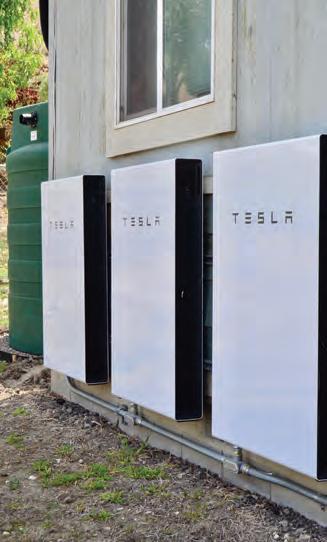
14 minute read
COVER
The future is electric
Push to eliminate fossil fuels intensifies
by Kimberly Rivers
kimberly@vcreporter.com
The ground mounted solar array at the Merkord home in Bardsdale.
Photo by Kimberly Rivers.
The science is clear. The time is now. The future is electric.
Moving away from fossil fuel-based energy and fuels is required to combat a warming planet. But there is still resistance on many fronts to the shift away from the energy sources humans have relied on for more than a century. Whether the objections are related to infrastructure, economic impacts, shifts in job skills or concerns about costs to the individual, the debate over halting the practices that lead to the release of greenhouse gas emissions is heating up.
According to the report “Approaches to Zero Net Energy Cost Effectiveness in New Homes,” published this month by the Energy Research and Development Division of the California Energy Commission (CEC) (1), “Transitioning to zero net energy all-electric new single-family and multi-family homes by 2023 would result in more than 50 metric tons of carbon dioxide cumulative savings from 2023– 2050...resulting in 3.3 million metric tons net carbon dioxide savings in 2050.”
A 2018 report issued by the CEC found that greenhouse gas emissions from buildings are second only to transportation in terms of contributing to climate change. (2) With that information the CEC is moving to incentivise zero net energy commercial and residential buildings.
A “zero net energy” (ZNE) building is defined by the state of California as a building “in which the value of the energy produced by onsite renewable energy resources is equal to the value of the energy consumed annually by the building.”
Climate vs. cost?
The debate over the electrification of new construction and of existing homes and buildings is intensifying. Climate activists are asking for legislation that will require all new construction to abandon natural gas connections, incentivise electrification at the local level, and convert municipal-owned properties to electric. These efforts are receiving push back in some areas from elected officials and the fossil fuel industry. The reason, stated again and again, is cost.
During the stakeholder input phase of the recent CEC study, building contractors expressed that “the sooner that full zero net energy compliance is required, the sooner that cost reductions associated with building ZNE homes will occur.”
Other concerns related to the public market not being ready to fully move to all electric were expressed by some in the building trades including that “remaining gas customers would bear the operational and maintenance expenses for the existing gas infrastructure” if its need is reduced, and that there is still “a consistent demand for gas cooktops, gas dryers, and gas furnaces.” Researchers pointed out that public education is an important part of the effort to electrify.
In August 2020, the California Public Utilities Commission (CPUC) abandoned a long-standing rule that required climate-friendly building approaches to be cost neutral. The newly adopted methodology, referred to as the “Fuel Substitution Test,” requires that mandates aimed at cutting carbon emissions in construction — helping a building reach ZNE status — must save energy and not harm the environment, but do not need to pass a “cost-effectiveness threshold” as previously required by the CPUC’s old “three-prong approach.” (3)
The new approach doesn’t automatically mean changes will cost more, however. In the long run, as technology advances, prices drop, builders become more familiar with the technology and long-term savings are realized and understood, the overall cost to the individual consumer — not to mention to the climate — will be lower.

Long-term savings
As of Jan. 1, 2020, all new buildings must comply with standards approved in 2019 by the CEC for building energy efficiency. This includes additions and alterations to residential and nonresidential buildings.
The 2019 standards emphasize accepted methods of achieving energy efficiency, such as photovoltaic systems and improvements for attics, walls, water, heating and lighting. There is some flexibility in the standards that allow customization based on location.
Research reported in April 2021 by the Lawrence Berkeley National Laboratory for the CEC found “that optimally designed single-family and multifamily homes result in lower customer lifecycle costs for all-electric... cases in all climate zones studied.”
Researchers also studied “mixed-fuel” homes and examined the potential of “renewable natural gas” (RNG) sourced from landfills, dairies, wastewater treatment plants and other sources. The study identified challenges
Ron Merkord
Photo by Kimberly Rivers.
to this fuel related to infrastructure and supply levels.
The study found that while all-electric homes did include higher initial costs comparable to “mixed-fuel homes,” eliminating the need for natural gas infrastructure contributed to lower costs upfront. In addition, “all-electric designs, if adopted by contractors, architects, building owners, residents, and property owners, can lower annual energy costs and realize an average of 38 percent annual carbon dioxide savings compared to mixed-fuel family homes.”
The report goes on to say that adoption of “all electric zero net energy homes across California will improve the health and safety of ratepayers by reducing criteria pollutants from natural gas combustion . . . Reduction of natural gas consumption by broader adoption of alternatives such as electrically powered heat pump-based water heating and space heating, will improve consumer and neighborhood safety by reducing natural gas distribution, possible leakage, and combustion for onsite heat generation.”
The research also anticipates that battery costs will decline in the future. With greater variety in battery size coupled with an expansion of permitting in California, prices on all aspects of going electric will come down.
According to the report, “The falling prices of rooftop solar photovoltaic and battery storage and the increasing availability of supply options such as community solar [where electricity production is shared by more than one household] and renewable natural gas will affect zero net energy new home cost-effectiveness and must be considered in plans for achieving state emissions reduction goals.”
Electric Farm
The property owned by Ron and Lisa Merkord of Bardsdale demonstrates one way to move toward an all-electric residence.
A system installed nine years ago at their 120-acre property on South Mountain Road has prevented 325,000 pounds of carbon dioxide from being emitted into the atmosphere, effectively reducing the carbon footprint of their home. That tally is calculated by the system itself, via digital readout, tracking the energy generated by the ground-mounted solar array at their home. Three Tesla Powerwalls are charged by the panels and provide backup electricity.
The Merkords purchased their property in 1996 to provide a home for the various exotic animals they cared for and for the wildlife education that took place through visits to see the Siberian tiger, black bear and wolves.
“I’ve always been really interested in solar, photovoltaic technology,” Merkord continued. “I remember when I was a kid and mowing lawns just so I could earn money,” to get the newest product from Edmund Scientific, a company selling science and technology gadgets and products for all ages. “It’s been a long term interest of mine.” Merkord graduated from the California Institute of Technology in Pasadena, and worked for ARCO Solar “doing photovoltaic design and development.” Today he repairs and sells lasers.
What triggered the move to solar power on his property was the purchase of electric vehicles. First it was the 2011 Chevy Volt, “their early plug-in hybrid… we absolutely loved it.” But the Merkords quickly realized that it does take a lot of electricity to charge a car, especially with a regular commute. “To keep the [Southern California] Edison [SCE] rates down, we put in solar to offset that.”
In 2012 they got a second Chevy Volt and installed a large solar array. Solar panels arranged on two large rectangles sit on a west-sloping hillside next to their house. “It’s about 15 kilowatts, which is bigger than what we could fit on the rooftop. It’s a ground-mounted system beside the house.” He calculated the array was enough to charge two electric vehicles for all of their driving, “and run the house.”
Merkord is pragmatic about the fact that their personal solar choices “aren’t going to change things,” acknowledging that climate change “is a worldwide problem... but it makes a moral statement. We talk to a lot of people about it. We spread the word and maybe affect the world a little bit that way.”
Today they have two Tesla vehicles, a couple of electric ATVs used on the ranch and a cadre of all-electric yard tools, lawn mowers and chainsaws, powered by the sun.
Today solar systems are not factored in for property tax
State incentives to decarbonize
California is allocating millions of dollars to incentivise electrification at various stages, including new construction and retrofits. As of April 2021 the following programs are either active or in the process of being implemented: • Southern California Edison fire rebuild program: provides incentives for all electric rebuilds for homes damaged by wildfires. • $6.7 million allocated for electric appliances including water pump/heaters, HVAC systems, clothes dryer and induction stoves. • $31 million for residential and commercial appliance retrofits. • $80 million in contractor incentives to build all electric homes. Details are online at www.cpuc.ca.gov/buildingdecarb



assessment purposes. In 2012, however, won’t cut the Merkords’ power. “Since there were concerns that the Merkords we’ve had the property three fires have solar array would affect assessed property burned through the ranch . . . even if . . . a values. A lease allowed them to avoid the fire burns all the lines along South Mountax liability. “Officially we are leasing the tain Road, we won’t even notice it.” solar, but it’s already been paid off for the Only their main water pump, on a well next 25 years,” Merkord explained. shared with a neighboring property owner,
Relying largely on solar had some relies solely on power from SCE. They drawbacks early on. do have water storage, enough to “go
“The only hiccup is when Edison would for weeks at a time just on what we have go down, it also shut down power to the stored.” But Merkord admitted that if the house,” Merkord said, as the SCE system power goes down for a long period of was needed to operate the converters. time, they would have an issue with their “This became a serious problem with the water supply. He is considering switching Public Safety Power Shut Offs [PSPO] the well pump to something smaller that that became quite would be run off the common after the fire solar system. lawsuits . . . It got so Another future bad, one month where plan is to move away out of 30 days, we had from propane for no power for at least heat and hot water. part of the day for 23 “It uses a very small days. We were trying amount of propane. to live off little bat- The house is highteries and generators.” ly insulated so even AD PROOF
To solve this prob- on really cold mornlem they installed ings we don’t use Client: Alexander Home Services Ad Executive: Warren Barrett (805) 648-2244 three Tesla Power- the heater much.” Please check this proof over carefully and indicate all corrections clearly. You will have a “1st Proof”, “2nd Proof”, and “Final Proof”. If walls, at a cost of They are looking at we receive no proof after the 1st or 2nd Proofs, AD WILL RUN AS IS. If this proof meets your approval on the 1st proof, check off $27,000. The Power- options for an elec“FINAL PROOF (APPROVED)” box, date and sign at the bottom. walls charge directly tric hot water heater NOTICE: PLEASE FAX THIS PROOF TO (805) 648-2245 ASAP ISSUE: 4/15/21 off the solar panels that will run off of and provide a battery the panels. backup. “We recently
“We have loved replaced the propane them. Every time the stove and oven, for power shuts off, we have no problem. induction electric. So we’ve gotten away WE ARE HIRING Totally seamless, we from using gas for REFINISHING EXPERT – CAMARILLO TILE & STONE CARE don’t even notice it. cooking. In the next CHECK LIST: They are charged, The three Tesla Powerwalls at the few years, ideally, p phone number is correct p address is correct p expiration date is correct p spelling is correct they stay charged.” Merkord property. Photo by Kimberly Rivers. we will switch the
Under normal [water heater and PLEASE NOTE: DEADLINE FOR AD CHANGES IS 12:00 NOON THE TUESDAY PRIOR TO THAT ISSUES RELEASE. usage, the Merkords use solar during the heater] to electric, and won’t even need All advertising produced by the production department of Times Media Group, is the copyrighted property of Times Media Group. day and charge up the Powerwalls, which the propane.” use other than the placement of advertising in any of Times Media Group’s publications is prohibited without the express consenthey rely on at night rather than using the For the Merkords, “moving to electric” Times Media Group, plus any applicable fees.SCE electric system. Merkord has linked the solar and battery system to his smartcame from a desire to “do something about climate change. My wife and I both p OK to run Date: ______________________________ phone, which receives reports on battery levels, usage levels and charges. “How view it as the most serious problem facing humanity. We have a son, the world is This proof is to check for accuracy and is not intended to show quality of reproduction. p OK to run with correction Signature: __________________________ we use them also changes depending on going to be severely affected by climate JOB DESCRIPTION: CAMARILLO TILE & STONE CARE the weather.” change. We have a moral obligation...to (**Only apply if you have experience with tile and stone**) is looking for candidates who:
When they know there is going to be a move things in the right direction.” We are looking for someone who has experience in the tile • are experts in their field wind event and a PSPO is likely, they will and stone care industry. This should include a knowledge of: • refinishing and restoration • are dependable and have a strong work ethic • are responsible and on timeset the system to keep the batteries fully 1. Approaches to Zero Net Energy Cost 4-22 Sagent Marketing 2.5x6.indd 1 • tile & grout repair • are in good physical condition charged at 100%. Effectiveness in New Homes, • surface cleaning and sealing • are detail-oriented and good at problem-solving
Merkord said that the solar array and April 2021, Energy Research and • interior marble / stone cleaning, honing, polishing and sealing • are good with customers and coworkers three Powerwalls generate enough energy Development Division, California • commercial floor services to run everything, including the air con- Energy Commission, Gov. Gavin ditioning and all appliances. “The only Newsom. ww2.energy.ca.gov/ ABOUT OUR COMPANY: Our technicians clean and restore residential and commercial interiors – countertops, floors, patios and more. Owned thing we might cut back on is charging 2021publications/CEC-500-2021-025/ and operated by a third generation local family, we serve the central and south coast from Santa Barbara to the the cars.” If they had to drive a lot during CEC-500-2021-025.pdf Ventura and L.A. area. the PSPOs, they either don’t charge both 2. California Energy Commission’s 2018 cars at the same time, or only partially Integrated Energy Policy Report JOB TYPE: FULL-TIME (M-F 8 am-5 pm) charge them. www.energy.ca.gov/data-reports/ PAY: $25.00 - $30.00 / HR
Very rarely there will be a brief dimming reports/integrated-energy-policy-report of the lights when the system switches over 3. Decision modifying the energy QUESTIONS FOR OUR APPLICANTS: from solar to battery sourced. Otherwise efficiency three-prong test related to · We pay for travel: Are you able to work in Santa Barbara & Ventura County? · Do you have a valid California Driver’s License and a clean driving record?the only way they even know SCE has shut fuel substitution, California · Do you have tile and stone care experience? off power is through the smartphone app. “Our system runs everything, there is no Public Utilities Commission, Aug. 1, 2019. https://docs.cpuc. 805-403-7220 805.980.7058 change in lifestyle when Edison goes down.” ca.gov/PublishedDocs/Published/ www.CamarilloTileAndStone.com
With the Powerwalls, even a major fire G000/M310/K159/310159146.PDF




